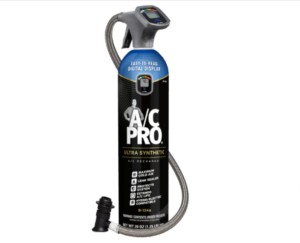Maintaining a comfortable car cabin temperature is crucial, especially during hot weather. Your car’s air conditioning (AC) system plays a vital role in this, and refrigerant is its lifeblood. If your AC isn’t blowing as cold as it used to, you might be wondering, “How Much To Recharge Ac Car?” This guide will walk you through the signs your AC needs a recharge, whether it’s a DIY job or time to see a professional, and what costs you might expect.
Understanding AC Recharge and Its Importance
Your car’s AC system uses refrigerant to cool the air. This refrigerant circulates, absorbing heat from inside your car and releasing it outside. When the refrigerant level is optimal, your AC system works efficiently, keeping your cabin cool and comfortable. However, over time, refrigerant can leak out, leading to a low charge.
A low refrigerant charge forces your AC system to work harder. The compressor, the heart of the AC system, has to strain to circulate the remaining refrigerant. This not only reduces cooling efficiency but can also put undue stress on components, potentially leading to premature compressor failure and more costly repairs down the line. Ensuring your AC system has the correct refrigerant charge is key to its performance and longevity.
Key Indicators Your Car AC Needs a Recharge
Recognizing the signs of low AC refrigerant can save you from discomfort and prevent further system damage. Here are some common symptoms to watch out for:
- Weak or Warm Airflow: This is the most obvious sign. If your AC vents are blowing warm or only slightly cool air, despite being set to maximum cooling, low refrigerant is a prime suspect. While other AC issues can cause this, it’s a strong indicator to check.
- AC Clutch Not Engaging: You might notice that the AC compressor clutch, an electromagnetic coupling mechanism, isn’t engaging. This clutch is responsible for engaging the compressor when cooling is needed. A low refrigerant level can prevent the clutch from engaging, as a safety mechanism to protect the compressor from running dry. You may hear clicking sounds or notice intermittent cooling.
- Cooling Only at Higher Speeds: If your AC only seems to cool effectively when you are driving at higher speeds, but struggles at idle or in slow traffic, it could be due to insufficient refrigerant. At higher engine speeds, the compressor might be able to circulate refrigerant enough to provide some cooling, but it’s not optimal.
- Foggy Windows Persist: Your car’s AC system also acts as a dehumidifier, removing moisture from the cabin air, especially when using the defrost setting. If your windows are slow to clear or remain foggy even with the AC on, low refrigerant could be the cause, as the system’s dehumidifying capability is diminished.
- Recent AC System Work: If you’ve recently had any part of your AC system replaced or opened for repair – such as the compressor, condenser, or lines – refrigerant would have been lost in the process. A recharge is necessary after any such work to restore the system’s functionality.
 AC Pro R134a Refrigerant Kit for DIY car AC recharge
AC Pro R134a Refrigerant Kit for DIY car AC recharge
DIY AC Recharge: Is It Right for You?
For minor refrigerant loss, DIY AC recharge kits are available at auto parts stores like AutoZone. These kits typically include a can of refrigerant, a charging hose with a gauge, and instructions. DIY recharge can be a cost-effective solution for topping off your system.
However, it’s crucial to understand the limitations and potential drawbacks of DIY AC recharge:
- Diagnosing the Root Cause: DIY kits primarily address the symptom (low refrigerant) and not the underlying cause. If there’s a leak in your AC system, simply adding refrigerant will only be a temporary fix. The refrigerant will eventually leak out again, and you’ll be back to square one.
- Overcharging Risk: Improperly using DIY kits can lead to overcharging the system, which can be as damaging as undercharging. Overcharging can cause excessively high pressures, potentially damaging components like the compressor or condenser.
- Environmental Concerns: Refrigerant is harmful to the environment. DIY recharge increases the risk of refrigerant leaks into the atmosphere if not handled carefully or if the underlying leak isn’t addressed.
- Limited Tools and Knowledge: DIY recharge doesn’t involve professional leak detection or system evacuation, which are crucial for proper AC service.
DIY recharge might be suitable if:
- You suspect a very minor, slow leak and want a quick top-up.
- You are comfortable following instructions carefully and using basic tools.
- You understand the risks and limitations.
When to Call a Professional for AC Service
For persistent AC issues or if you suspect a significant leak, seeking professional AC service is highly recommended. A certified AC technician has the expertise, tools, and equipment to:
- Accurately Diagnose Leaks: Professionals use specialized tools like leak detectors and UV dyes to pinpoint the source of refrigerant leaks, which is essential for a lasting repair.
- Evacuate and Recover Refrigerant: Before repairing any leaks or performing a full recharge, technicians properly evacuate the old refrigerant from the system using recovery equipment. This is environmentally responsible and necessary for accurate charging.
- Perform Vacuum Testing: After repairs, a vacuum test is performed to ensure the system is sealed and leak-free before recharging.
- Properly Recharge the System: Professionals use calibrated equipment to recharge the system with the correct type and amount of refrigerant, ensuring optimal performance and preventing overcharging or undercharging.
- Address Complex Issues: Beyond refrigerant leaks, professionals can diagnose and repair other AC system problems like compressor failures, condenser issues, expansion valve malfunctions, and electrical faults.
It’s definitely time for professional help if:
- Your AC loses charge frequently (more than once every few years).
- You suspect a significant leak.
- DIY recharge doesn’t resolve the issue.
- You are uncomfortable working on the AC system yourself.
AC Recharge Cost Breakdown
Now, let’s address the primary question: “how much to recharge ac car?” The cost of an AC recharge can vary depending on several factors:
- DIY Recharge Kit: A DIY AC recharge kit typically costs between $30 to $70, depending on the brand, refrigerant type, and included features like leak sealant. This is the cheapest option upfront, but remember it may not fix underlying issues.
- Professional AC Recharge: Professional AC recharge costs can range from $150 to $350 or more. This price usually includes:
- Refrigerant: The cost of the refrigerant itself. R-134a refrigerant, commonly used in older vehicles, is generally less expensive than the newer R-1234yf refrigerant used in many newer cars.
- Labor: The technician’s labor for diagnosis, evacuation, recharge, and potentially leak testing.
- Diagnostic Fees: Some shops may charge a diagnostic fee to assess the AC system before performing any work.
- Leak Repair (if needed): If a leak is found and needs repair, this will add to the overall cost. Leak repairs can range from minor sealant applications to replacing components like hoses, seals, or even the condenser or evaporator, significantly increasing the cost.
Factors influencing professional recharge cost:
- Vehicle Type: Luxury vehicles or those with more complex AC systems might have higher recharge costs.
- Refrigerant Type: R-1234yf refrigerant is significantly more expensive than R-134a, so recharges for newer vehicles using R-1234yf will be pricier.
- Location: Labor rates vary by location, affecting the overall cost.
- Shop Rates: Different auto repair shops have different labor rates. Dealerships tend to be more expensive than independent shops.
To get an accurate estimate for “how much to recharge ac car” professionally, it’s best to:
- Contact local auto repair shops: Call a few reputable shops in your area and ask for a quote for an AC recharge service. Be sure to ask what’s included in the price.
- Specify your vehicle: Provide the make, model, and year of your car when requesting quotes.
- Inquire about leak detection: Ask if the recharge service includes leak detection or if that’s an additional charge.
Conclusion
Knowing “how much to recharge ac car” involves considering both DIY and professional options. While DIY recharge can be a quick and cheaper fix for minor issues, it’s essential to be aware of its limitations. For long-term AC health and to address potential leaks or more complex problems, professional AC service is the recommended route. AutoZone offers a wide range of AC recharge products and can also help you find qualified professional mechanics in your area if you decide to seek expert help.
FAQ About Car AC Recharge
How do I know if my car’s AC needs to be recharged?
If your car’s AC is blowing warm air, not cooling effectively, or exhibiting other symptoms like weak airflow or persistent foggy windows, it likely needs attention and potentially a recharge.
What are the signs of a faulty car AC system beyond just needing a recharge?
Signs of a more serious faulty car AC system can include strange noises (rattling, hissing), foul odors coming from the vents, visible refrigerant leaks (oily residue), and complete AC failure even after recharge attempts.
Can I recharge my car’s AC myself, or should I seek professional help?
You can recharge your car AC yourself with a DIY kit for minor top-ups. However, for proper diagnosis, leak repair, and optimal system performance, professional help is generally recommended, especially for persistent issues or suspected leaks.
What are the potential risks of improperly recharging a car’s AC?
Potential risks of improperly recharging a car’s AC include damage to the compressor or other system components due to overcharging, refrigerant leaks into the environment and your car cabin, and ineffective cooling if undercharged.
How long does it typically take to recharge a car’s AC?
A DIY AC recharge can take about 30 minutes to an hour. Professional recharge service, including diagnosis and evacuation, may take 1 to 2 hours, or longer if leak repair is needed.
What is the average cost of a car AC recharge?
The average cost of a DIY car AC recharge is $30-$70. Professional AC recharge cost ranges from $150 to $350 or more, depending on vehicle, refrigerant type, and labor.
How often should a car’s AC system be recharged?
A car’s AC system should only be recharged when necessary due to refrigerant loss. It’s not a routine maintenance item. Frequent recharges indicate a leak that needs professional attention.
Are there any alternative methods to fix a car’s AC system without recharging?
Yes, fixing leaks, replacing faulty components like the compressor, condenser, expansion valve, or repairing electrical issues are alternative methods to address AC problems without simply recharging. These require professional diagnosis and repair.
